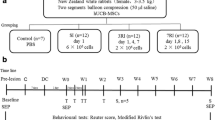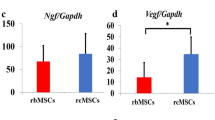Abstract
Purpose
Mesenchymal stem cell (MSC) transplantation has been touted as a possible treatment for spinal cord injury (SCI) patients’ locomotor and neurological rehabilitation. The intralesional injection of MSC is a typical delivery route for SCI, although this can result in further injury. We conducted the study with the aim of characterizing canine bone marrow–derived MSC (cBM-MSC) and evaluating the relative efficacy of different routes of cBM-MSC transplantation on regeneration of SCI in rabbits.
Methods
The cBM-MSCs were isolated, cultured, and characterized using an established protocol. The in vitro neuronal differentiation potential of the cBM-MSCs was examined by culturing them into neuronal differentiation medium. The spinal injury was created by epidural microballoon compression following a right microhemilaminectomy in thirty rabbits that were divided into five groups based on treatment: untreated sham control, vehicle control, and transplanted with cBM-MSCs through intravenous (IV), intralesional (IL), and intracisternal (IC) routes on the 24 h and 7th day post-injury. The efficacy of cBM-MSC transplantation was evaluated based on the hind limb function scoring and histopathology.
Results
The cBM-MSCs on characterization were found to be CD44-, CD90-, and CD105-positive, and CD45-negative. The differentiation was confirmed by immunocytochemistry, through which the specific marker β-tubulin III for the neurons was detected. The IC group had the best functional recovery, followed by the IL group, and the IV group had the worst. Histopathological findings of the spinal cord on days 30 and 60 correlated with the clinical findings.
Conclusions
The results indicated that the epidural microballoon compression following a right microhemilaminectomy was found to be minimally invasive and easily reproducible for the SCI model. Intracisternal transplantation of cBM-MSCs may be used for effective functional recovery of spinal injury.
Lay Summary
Herein, an optimal method to transplant MSC into the injured spinal cord to facilitate functional recovery was established in rabbits. The cBM-MSCs were isolated, cultured, and characterized. The in vitro neuronal differentiation of the cBM-MSCs was confirmed, and cultured cBM-MSCs were transplanted in rabbits with spinal injury. The efficacy of cBM-MSC transplantation was evaluated based on the hind limb function scoring and histopathology. Intracisternal transplantation was associated with the greatest functional improvement.






Similar content being viewed by others
References
Becker T, Anliker B, Becker CG, Taylor J, Schachner M, Meyer RL, et al. Tenascin-R inhibits regrowth of optic fibers in vitro and persists in the optic nerve of mice after injury. Glia. 2000;29:330–4.
Fawcett JW, Asher RA. The glial scar and central nervous system repair. Brain Res Bull. 1999;49:377–91.
McKerracher L, David S, Jackson DL, Kottis V, Dunn RJ, Braun PE. Identification of myelin-associated glycoprotein as a major myelin-derived inhibitor of neurite growth. Neuron. 1994;13:805–11.
Merkler D, Metz GA, Raineteau O, Dietz V, Schwab ME, Fouad K. Locomotor recovery in spinal cord-injured rats treated with an antibody neutralizing the myelin associated neurite growth inhibitor Nogo-A. J Neurosci. 2001;21:3665–73.
Schnell L, Schwab ME. Axonal degeneration in the rat spinal cord produced by an antibody against myelin-associated neurite growth inhibitors. Nature. 1990;343:269–72.
Skene JH. Axonal growth-associated proteins. Annu Rev Neurosci. 1989;12:127–56.
Widenfalk J, Lundstromer K, Jubran M, Brene S, Olson L. Neurotrophic factors and receptors in the immature and adult spinal cord after mechanical injury or kainic acid. J Neurosci. 2001;21:3457–75.
Schwartz M. Autoimmune involvement in CNS trauma is beneficial if well controlled. Prog Brain Res. 2000;128:259–63.
McCreedy DA, Sakiyama-Elbert SE. Combination therapies in the CNS: engineering the environment. Neurosci Lett. 2012;519:115–21.
Akiyama Y, Radtke C, Honmou O, Kocsis JD. Remyelination of the spinal cord following intravenous delivery of bone marrow cells. Glia. 2002;39:229–36.
Chopp M, Zhang XH, Li Y, Wang L, Chen J, Lu D. Spinal cord injury in rat: treatment with bone marrow stromal cell transplantation. NeuroReport. 2000;11:3001–5.
Parr AM, Kulbatski I, Tator CH. Transplantation of adult rat spinal cord stem/progenitor cells for spinal cord injury. J Neurotrauma. 2007;24:835–45.
Pittenger MF, Mackay AM, Beck SC, Jaiswal RK, Douglas R, Mosca JD, et al. Multilineage potential of adult human mesenchymal stem cells. Science. 1999;284:143–7.
Ferrari G, Cusella-De Angelis G, Coletta M, Paolucci E, Stornaiuolo A, Cossu G, et al. Muscle regeneration by bone marrow-derived myogenic progenitors. Science. 1998;279:1528–30.
Orlic D, Kajstura J, Chimenti S, Bodine DM, Leri A, Anversa P. Transplanted adult bone marrow cells repair myocardial infarcts in mice. Ann N Y Acad Sci. 2001;938:221–9.
Kohyama J, Abe H, Shimazaki T, Koizumi A, Okano H, Hata J, et al. Brain from bone: efficient “meta-differentiation” of marrow stroma-derived mature osteoblasts to neurons with Noggin or a demethylating agent. Differentiation. 2001;68:235–44.
Sanchez-Ramos J, Song S, Cardozo-Pelaez F, Hazzi C, Stedeford T, Willing A, et al. Adult bone marrow stromal cells differentiate into neural cells in vitro. Exp Neurol. 2000;164:247–56.
Kumar M, Yasotha T, Singh RK, Singh R, Kumar K, Ranjan R, et al. Generation of transgenic mesenchymal stem cells expressing green fluorescent protein as reporter gene using no viral vector in caprine. Indian J Exp Biol. 2013;51:502–9.
Woodbury D, Schwarz EJ, Prockop DJ, Black IB. Adult rat and human bone marrow stromal cells differentiate into neurons. J Neurosci Res. 2000;61:364–70.
Basso DM, Beattie MS, Bresnahan JC, Anderson DK, Faden AI, Gruner JA, et al. MASCIS evaluation of open field locomotor scores: effects of experience and teamwork on reliability. Multicenter Animal Spinal Cord Injury Study. J Neurotrauma. 1996;13:343–59.
Tarlov IM. Spinal cord compression: mechanism of paralysis and treatment. Springfield, Ill: Charles C. Thomas. 1957; p 147
Olby N, Harris T, Burr J, Munana K, Sharp N, Keene B. Recovery of pelvic limb function in dogs following acute intervertebral disc herniations. J Neurotrauma. 2004;21:49–59.
Kim JW, Ha KY, Molon JN, Kim YH. Bone marrow-derived mesenchymal stem cell transplantation for chronic spinal cord injury in rats: comparative study between intralesional and intravenous transplantation. Spine. 2013;38:E1065–74.
Mothe AJ, Bozkurt G, Catapano J, Zabojova J, Wang X, Keating A, et al. Intrathecal transplantation of stem cells by lumbar puncture for thoracic spinal cord injury in the rat. Spinal Cord. 2011;49:967–73.
Cizkova D, Novotna I, Slovinska L, Vanicky I, Jergova S, Rosocha J, et al. Repetitive intrathecal catheter delivery of bone marrow mesenchymal stromal cells improves functional recovery in a rat model of contusive spinal cord injury. J Neurotrauma. 2011;28:1951–62.
Bakshi A, Barshinger AL, Swanger SA, Madhavani V, Shumsky JS, Neuhuber B, et al. Lumbar puncture delivery of bone marrow stromal cells in spinal cord contusion: a novel method for minimally invasive cell transplantation. J Neurotrauma. 2006;23:55–65.
Takahashi Y, Tsuji O, Kumagai G, Hara CM, Okano HJ, Miyawaki A, et al. Comparative study of methods for administering neural stem/progenitor cells to treat spinal cord injury in mice. Cell Transplant. 2010;20:727–39.
Mansilla E, Marin GH, Sturla F, Drago HE, Gil MA, Salas E, et al. Human mesenchymal stem cells are tolerized by mice and improve skin and spinal cord injuries. Transplant Proc. 2005;37:292–4.
Wu J, Feng D, Yang T. Effect of transplanting marrow mesenchymal stem cells via subarachnoid space on spinal cord injury and T cell subpopulation in rats. Zhongguo Xiu Fu Chong Jian Wai Ke Za Zhi. 2007;21:492–6.
Bakshi A, Hunter C, Swanger S, Lepore A, Fischer I. Minimally invasive delivery of stem cells for spinal cord injury: advantages of the lumbar puncture technique. J Neurosurg. (Spine 1) 2004;3:330–7.
Chen Q, Long Y, Yuan X, Zou L, Sun J, Chen S, et al. Protective effects of bone marrow stromal cell transplantation in injured rodent brain: synthesis of neurotrophic factors. J Neurosci Res. 2005;80:611–9.
Rosenzweig ES, McDonald JW. Rodent models for treatment of spinal cord injury: research trends and progress toward useful repair. Curr Opin Neurol. 2004;17:121–31.
Carvalho KA, Vialle EN, Moreira GH, Cunha RC, Simeoni RB, Francisco JC, et al. Functional outcome of bone marrow stem cells (CD45(+)/CD34(-)) after cell therapy in chronic spinal cord injury in Wistar rats. Transplant Proc. 2008;40:845–6.
Acknowledgements
The authors are thankful to Director ICAR-IVRI for providing all the facilities to carry out the present research work.
Funding
The study was funded by ICAR-Indian Veterinary Research Institute, Izatnagar, Uttar Pradesh, India, under the MVSc research program to the first author.
Author information
Authors and Affiliations
Contributions
All authors contributed to the study conception and design. Material preparation, data collection, and analysis were performed by A. Suvarna, A. C. Saxena, Rajendra Singh, and Sadhan Bag. The first draft of the manuscript was written by Vineet Kumar and all authors commented on previous versions of the manuscript. All authors read and approved the final manuscript.
Corresponding author
Additional information
Publisher's Note
Springer Nature remains neutral with regard to jurisdictional claims in published maps and institutional affiliations.
Rights and permissions
Springer Nature or its licensor (e.g. a society or other partner) holds exclusive rights to this article under a publishing agreement with the author(s) or other rightsholder(s); author self-archiving of the accepted manuscript version of this article is solely governed by the terms of such publishing agreement and applicable law.
About this article
Cite this article
Suvarna, A., Hoque, M., Saxena, A.C. et al. The Effect of Different Routes of Xenogeneic Mesenchymal Stem Cell Transplantation on the Regenerative Potential of Spinal Cord Injury. Regen. Eng. Transl. Med. 9, 407–415 (2023). https://doi.org/10.1007/s40883-022-00290-x
Received:
Revised:
Accepted:
Published:
Issue Date:
DOI: https://doi.org/10.1007/s40883-022-00290-x




